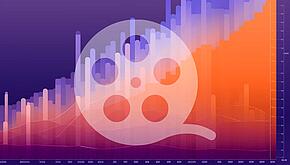- Why Us?
- Features
White Label
For SaaS Platforms & Agencies
Provide our complete analytics suite to your clients, directly within your own interface and with your/their own branding. Discover Analytics-as-a-Service and White Label Analytics. Great benefit, minimal effort.
- Pricing
- White Label
- Success Stories
- Partner
- ResourcesExpand Your Knowledge
CONTENTS
- What Are Conversion Funnels?
- Conversion Funnel Modeling
- Digital Conversion Funnel Marketing
- Website Analytics Conversion Funnels
- Importance of Conversion Funnels
- Common Issues With Conversion Funnels
- How the Conversion Funnel Analytics Feature Works
- How to Optimize Your Conversion Funnel
- Top of the Funnel Optimization
- Middle of the Funnel Optimization
- Bottom of the Funnel Optimization
- FAQs
- How Does a Conversion Funnel Work?
- What Are the Stages in the Conversion Funnel?
- What Is the Difference Between Conversion Funnels, Marketing Funnels, and Sales Funnels?
- What Is a Conversion Funnel in eCommerce?
- What Is the Top to Bottom Conversion Funnel Like on A SaaS Business?
- How to Calculate the Sales Funnel Conversion Rate
- What Is a Good Funnel Conversion Rate?
- What Is a Conversion Funnel in Web Analytics?
- Can Conversion Funnels Show the Source of Converted Users?
- How Can I Find Out the Efficacy of a Conversion Funnel On My Website?
- What Is the Best Way to Visualize a Conversion Funnel?
- How Can I Create a Conversion Funnel?
- How Do You Optimize a Conversion Funnel?
- How to Analyze a Conversion Funnel
- How to Analyze the Conversion Funnel of a B2C SaaS Company?
- Should eCommerce Conversion Funnels Include the Shopping Cart?
- How Do You Measure Improvements to a Conversion Funnel Over Time?
- How Do I Build a Social Media Marketing Conversion Funnel?
- What Are the Most Important KPIs for Conversion Funnel Optimization?
- What Is the Best Automated Conversion Funnel/Sales Funnel Software?
- Why Are Conversion Funnels Effective in 2023?
What Are Conversion Funnels? A Guide for Digital Marketers
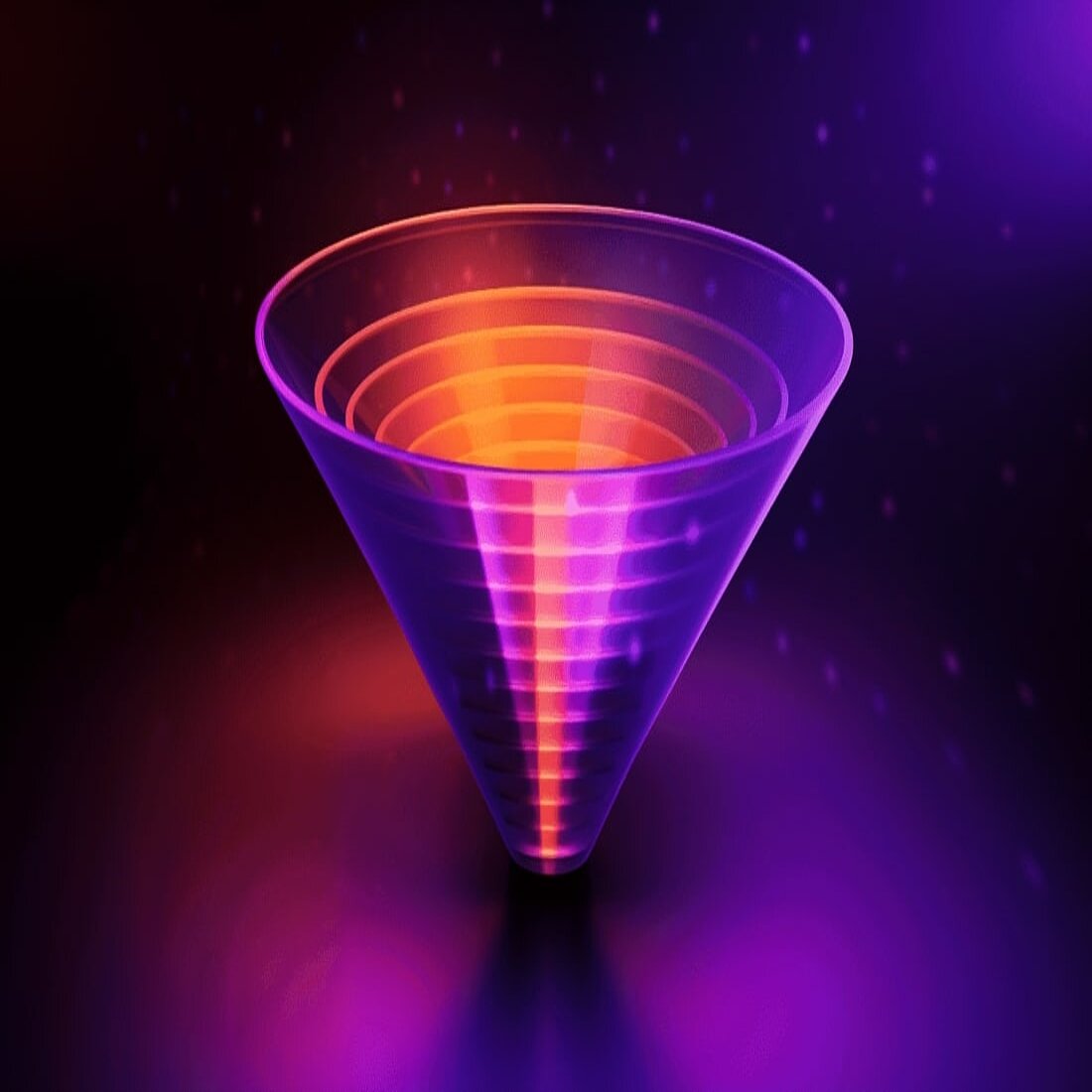
What are conversion funnels if not an analogy for business itself?
Conversions represent sales, sign ups, or other similarly key user actions - making conversion rates the lifeblood for any business since trade became a thing.
Conversion funnels are simply the journeys that eventual converts take to purchase and every online seller has at least one, whether they realize it or not.
Conversion funnel analysis uncovers these sometimes-hidden digital paths, and provides insights that you can use to both improve them and optimize new ones to suit different audiences, products, and campaigns.
Ultimately, conversion funnels guide marketing activities towards the specific goal of increasing conversion rates. They enable you to identify your best channels and approaches for high quality lead generation, as well as the likely obstacles to purchase. And when used well, they’ll also bring in more repeat business and improve customer retention in the long term.
It’s a simple process, but one that will increase both marketing ROI and sales revenue.
This will pour you into the theory behind conversion funnels, through their strengths and weaknesses, and down to advice on creating an effective conversion funnel marketing strategy. It will then finish off with some frequently asked questions if you haven’t quite found what you’re looking for.
It will also discuss the conversion funnel analytics feature provided by website intelligence solutions like TWIPLA. This tool simplifies conversion funnel analysis, and is a great way for digital marketers to integrate conversion funnel theory into their marketing strategies.
What Are Conversion Funnels?

Sales are the visible hand that controls every business, and conversion funnels are the journeys - be it physical or in the digital world - that their buyers take to purchase.
This theory breaks down these journeys into a small number of distinct phases, and provides marketers with a categorized structure for content delivery that is proven to improve conversion rates. Today, many businesses use it to dissect their marketing strategies, and to monitor the performance of their various webpages, channels, and campaigns.
Feel free to look at our infographic for a colorful snapshot of this idea.
Conversion funnels are also a tool provided by website intelligence platforms. These are an advanced modern interpretation of the conversion funnel marketing theory, and provide rich insights into user behavior that can be used for cost-effective website optimization regardless of your industry.
Let’s have a look at this marketing model, conversion funnel marketing, and the website analytics tool this theory spawned in more detail:

Conversion Funnel Modeling
Over the millenia, many people would have been quite delighted to learn the secret to increasing the chances of a sale. Some probably searched for it in divinity, sorcery, or alchemy - or attempted to stitch together a Frankenstein’s monster from the three. But it was actually in Philadelphia that the sales process as we know it today was formulated.
Ad executive Elias Saint Elmo Lewis had marketing’s falling apple moment in 1898, inventing the first formal theory of marketing. He called it the AIDA model, with the term an acronym for the four buyer stages that he identified:
- Awareness - they first becomes conscious of your business, products, or services
- Interest - they want to learn more about what your business offers
- Desire - they become interested in buying something from you
- Action - they decide to buy something from you
Lewis’s AIDA model is a wonderfully descriptive theory that anyone can understand. It breaks down the average person’s buying process into four distinct stages - or states of mind - that need to be facilitated by the merchant to increase the likelihood of a successful sale.
Of course, Lewis’s marketing model has been developed over the last century, but not enormously - the fundamentals are still the same. One of the main changes is one of terminology, with the AIDA model now more commonly known as the conversion funnel.
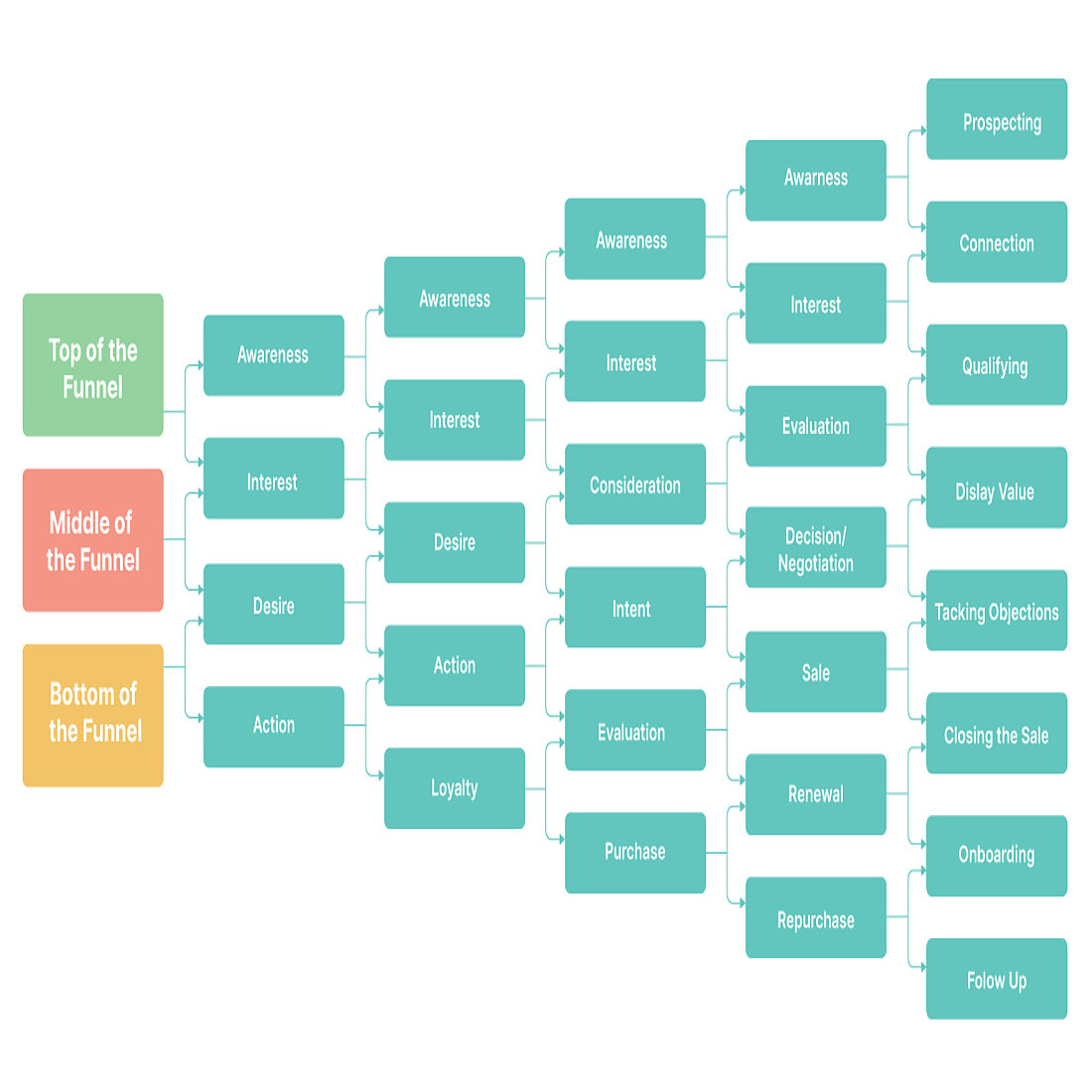
You can see why.
A funnel is a really useful metaphor for illustrating how the large number of prospects who hear about your business gradually erodes down to the smaller group who are eventually persuaded to open their wallets.
Conversion funnels are also known as a sales, marketing, website, and customer funnel. And while these names can be thrown around interchangeably, they aren't exactly the same. The differences come from their final objectives - be it a sale, lead generation, and so forth - but they all share the same fundamental conversion funnel modeling.
Another noticeable change has been the addition of a fifth, post-conversion stage to the AIDA model:
- Retention - businesses maintain a relationship with converted customers, who are likely to be open to rebuying, upselling, cross selling, referrals, advocacy, and so forth
It’s fairly obvious why this has been added. Customers aren’t suddenly as dead to you as Christmas in July the moment they close their wallets again. Hopefully, they’re happy shoppers who will buy from you again, become loyal customers, and wax lyrical about your virtues long into the future.
Given this, maybe it’s more accurate to talk about endless conversion funnel pipelines since the goal of businesses is to keep hold of customers for as long as possible. This explains why most modern conversion funneling includes the retention stage, and why those that don’t include it are about as useful as a lighthouse at midday.
Beyond this regular addition, it’s common to find other explanations that slice the sales process up like a blind kebab shop worker to serve up as many as nine different stages. Others probably go further, but these are still all basically subdivisions of the four or five stages already outlined, with some examples listed below:
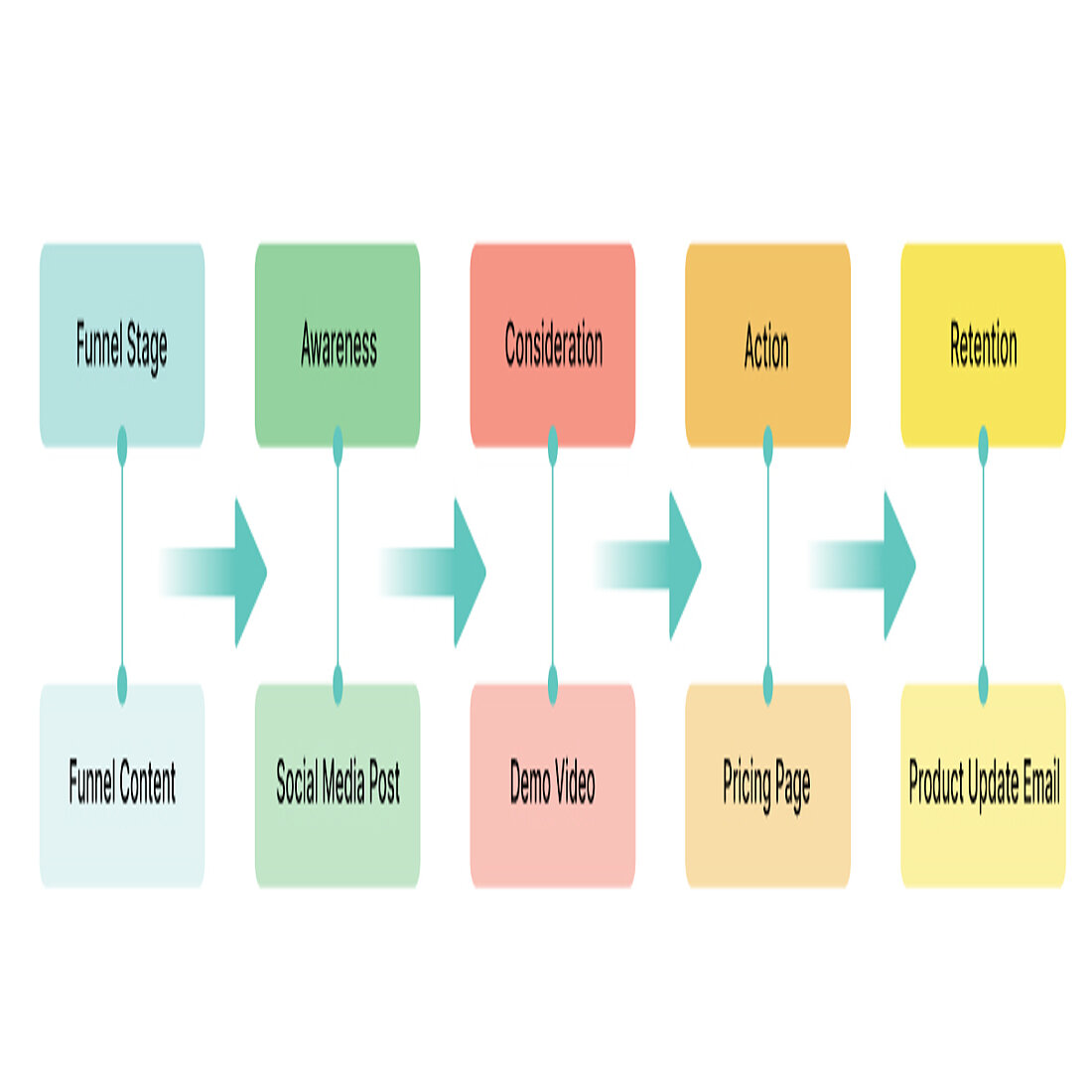
Digital Conversion Funnel Marketing
Conversion funnels have long been used to structure how salesmen approach potential buyers, despite offering little more than rough conversation cues for the more awkward among them.
However, Lewis’ old model has proved to be strikingly adaptable to modern digital technologies. Today, businesses can easily build marketing strategies around tangible conversion objectives, and all outreach can be published, analyzed, and improved around conversion funnel optimization benchmarks.
Ultimately, everything you create online forms part of your conversion funnel, and can be categorized as such for conversion funnel marketing. And, in terms of the content itself, you can find a pretty exhaustive list of where webpages and other digital elements fit into conversion funnel theory below:
| Funnel Stage | Appropriate Digital Marketing Materials | ||
|---|---|---|---|
| Awareness |
|
|
|
| Consideration |
|
|
|
| Action |
|
|
|
| Retention |
|
|
|
One thing to take away from the above table is that your business already has multiple funnels that bring buyers towards a key action. Some will be short - for instance, a single social media post linking to a purchase page - while others will be longer, with users snaking through different awareness and consideration content before eventually converting.
But when doing conversion funnel marketing, it’s better to keep things simple at the beginning - particularly since your shortest funnels will include your most important webpages, and whose improvement will have a knock-on effect on many of your other funnels as a result.
For instance, you could start by analyzing a funnel that is made up of a customer testimonials article, and then the signup page that it is linked to, and to use these insights to make data-driven improvements to these pages - thus optimizing the funnel over time.
Later, you could increase the size of the funnel by adding another preliminary step to it - maybe a linked post on your highest-performing social media channel, and to use the data from conversion funnel analysis to make changes that will increase the number of people that will convert.
Start carrying out conversion funnel analysis in this way, and you’ll soon start seeing the fruits of your website optimization labor. You can also develop as many funnels as you want, and can use them to target different audience segments and effectively drive up conversion rates regardless of the route to purchase.

Conversion Funnel Marketing and Website Structure
Of course, website visitors cannot physically see these underlying funnels - for them, the content in the table above exists largely separately. To conversion funnel marketers however, it’s created to satisfy whatever question users have next about the business, and to direct them seamlessly towards conversion.
This explains the importance of website design, intuitive navigation, and the wider user experience to conversion funnel marketing.
Ultimately, website visitors need to be able to easily find what they need to move along to the next stage of the funnel - they’re more likely to leave if they can’t find what they need intuitively, or if they encounter bugs, broken links, or other annoying technical issues.
As such, user testing is a great way to improve funnels, and can actually increase conversion rates three fold.
Practically, good conversion funnel marketing also means adding relevant interlinking throughout webpages that guides them directly down the funnel. For instance, you could create a simple funnel based on the first appropriate webpage taken from each funnel stage in the previous table, with the journey shown below:
Conversion Funnel Optimization
As you can imagine, there’s no end to the number of different routes that users can take to purchase - particularly as a website grows and more marketing channels feed into it. Optimizing each one will take time, and is a task best started by prioritizing cornerstone webpages that will form part of the largest number of your conversion funnels.
The ultimate goal of conversion funnel optimization is to find the point where the sales process breaks down most often, and to increase the proportion of people who move past it - something that can easily be verified by monitoring the progression ratios along the full length of the funnel.
Of course, you need to also then pinpoint exactly what’s causing this user behavior, and content marketers do this by using other website analytics tools like heatmaps, session recordings, and A/B testing to work out how to best optimize the webpage in question.
Conversion Funnel Content
Conversion funnel optimization ultimately requires that users are able to find the information they need at any given moment in their browsing session. Many of them will also need to be persuaded to move further down the funnel, and this explains the importance of quality content that is well written, designed, and displayed.
Bad content - be it confusing, dull, or uninformative - can easily pull the credibility rug from under your business and push users away. High quality content matters to conversion funnel marketing; it helps build trust, desire, and urgency, and is vital for keeping funnels unblocked, and conversion rates high.
There’s a great example of a website analytics company that couldn’t understand why their signup rate was so low. They’d run conversion funnel analysis and found that the payment page was experiencing a high volume of traffic, but people weren’t performing the final action in the frequency expected.
The bounce rate was huge, despite the simplicity of what was a standard monthly pricing plan page - and far more people had followed the funnel leading up to it than the final conversion ratio reflected.
Cue much head scratching.
They watched some session recordings and carried out heatmap analysis of the webpage, and identified the blockage - there was a single line of text that confused their message and made their payment options much less attractive than they actually were.
So they reworded the sentence and saw their conversion rate skyrocket by 10%.

Website Analytics Conversion Funnels
Conversion funnel marketing has moved beyond simply creating webpages that answer the needs of customers and prospects at every stage of their sales journey, and has been turned into a potent analytics tool for online business that is also known by the same name.
Conversion funnel marketing has moved beyond simply creating webpages that answer the needs of customers and prospects at every stage of their sales journey, and has been turned into a potent analytics tool for online business that is also known by the same name.
We’ve already written elsewhere about the top 10 conversion funnel tools available to digital marketers.
The conversion feature provided by our own TWIPLA website intelligence platform is an equally great way to analyze the effectiveness of your conversion funnel marketing strategy, particularly since its privacy-perfect design ensures compliance with GDPR and other data privacy laws.
It enables you to easily categorize key pages according to their position in the funnel, and to then daisy-chain them towards the specific conversion that you want to look into. This only takes a few minutes to set up, but it gives you an immediate understanding of how your funnel is performing.
Importance of Conversion Funnels
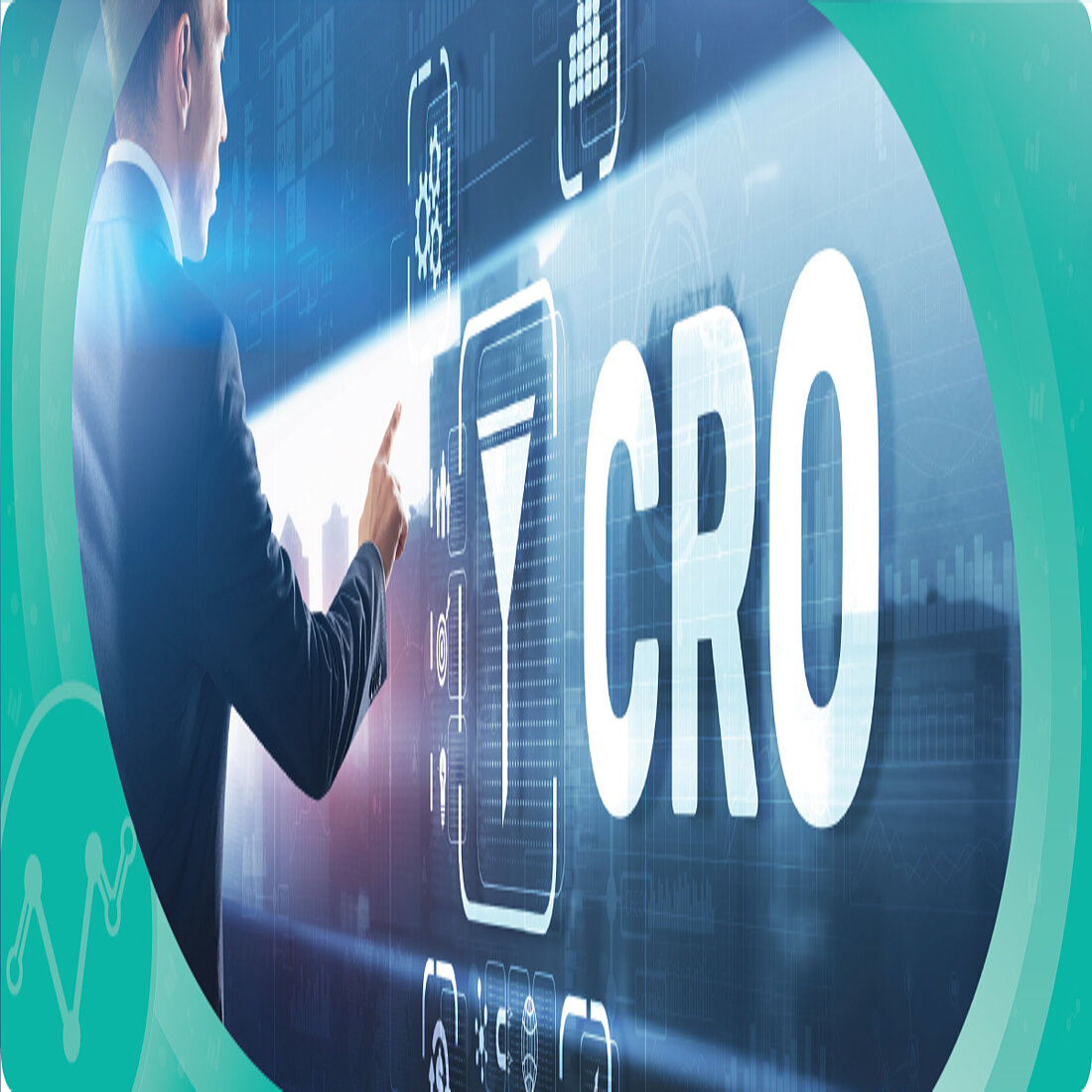
Businesses need an effective lead generation and conversion process to be successful in what is a highly competitive modern marketplace. This means that they are themselves conversion funnels in all but name, and need to fully optimize their capacity across all the various stages involved to be truly successful.
Conversion funnel analysis is ideally suited to this task, and we’ve already written at length about the five key benefits of conversion funnel tools.
But in a nutshell, Lewis’ model breaks the sales journey down into only four or five stages; and while this may look simplistic, these thick brushstrokes are still enough to paint an accurate picture of what consumers need from businesses in the leadup to a sale.
The model has become even more effective in the digital marketing age since website intelligence solutions like TWIPLA make it very simple to build webpage conversion funnels, and to accurately see how each stage is performing.
It ultimately provides your business with a way to dissect its marketing strategy, and to accurately identify which stages are working well, which ones aren’t, and where the sales journey breaks down most often. It also provides you with the insights you need to optimize your conversion funnels across the sales journey and beyond.
Crucially, conversion funnel analysis strips website optimization down to what should be your priority from the beginning - increasing conversion rates. It shows you your highest traffic pages, most common paths to purchase, and where your highest quality leads - those that went on to convert - originated from.
This data is great for decision makers, since it opens the hood of the capacity of your various marketing channels and campaigns, enabling you to see which ones are performing well, and which others need to be approached differently.
Optimization is incremental, but an increase of just 1% means that you’re getting one new customer for every 100 website visitors - a substantial increase given how many internet users can visit a website. Ultimately, this is great for website performance; even a tiny conversion rate gain will drive revenue growth and help you to achieve a much better marketing ROI.
What’s more, the conversion funnel is a website user behavioral tool.
This is important, since it helps you to understand how people interact with your website, as well as the intent and motivation behind each action as they move along the conversion funnel. They’re also very useful for pinpointing technical issues, and other obstacles along the sales journey.
Common Issues With Conversion Funnels

Conversion funnel optimization can have an immediate and tangible impact on your sales volumes, brand loyalty, and business reputation. However, there are still a few things to consider before integrating them into your marketing strategy.
Firstly, the modern buying process is not quite as linear as conversion funnel modeling would like it to be. Internet users don’t always arrive at your organization through a top-of-the-funnel page that you have created, nor will they naturally railroad directly through any sales journey that you have created.
Instead, internet users can arrive unannounced at any stage of the funnel, and reappear at random like a moth caught between two moons. Converts - on the way to purchase - can often skip stages, or oscillate between them before eventually opening their wallets.
Secondly, conversion funnel theory assumes that there is some mythical or finite end to the buyer journey. And while this has been somewhat rectified, guidance for the retention phase still feels a little tacked on - particularly when compared to the degree of sophistication to which the pre-conversion stages have been developed.
Finally, conversion is itself a superficial way to understand user behavior. Most modern consumers rarely visit a website with the express purpose of buying something, dislike pushy sales techniques, and will actually be more likely to buy from a company that offers an excellent customer experience.
However, conversion funnel marketing is not an obstacle to customer experience optimization since what these marketing approaches demand is pretty similar at the website level - interesting content, a smooth browsing experience without any technical issues, and the capacity for users to find the information they need easily.
These issues do still reveal one fundamental truth - that conversion funnels are an artificial way to pinpoint the intent behind the behavior of specific website visitors.
But let’s not throw the baby out with the bathwater.
This problem doesn’t make the findings of conversion funnel analysis any less helpful, particularly since other user behavior and visitor communication tools exist to work out user intent and to guide website optimization accordingly.
How the Conversion Funnel Analytics Feature Works

The conversion funnel feature will vary depending on what platform you’re using, but we’ll run through how it works with our TWIPLA suite. However, it's still important to remember that not all alternatives have this feature, so it’s best to check before making your choice.
Conversion funnel website analytics is an advanced modern interpretation of Lewis’ AIDA(R) model that enables you to follow the navigation path that website visitors take on their journey towards a successful conversion.
Much like some alternatives, our tool works thanks to the JavaScript that is integrated into your sales channel when you activate the website intelligence platform, but the specificities of websites, marketplace stores, and webpages themselves means that conversion funnels do still need to be set up manually - for the moment.
It’s important to get to grips with what this feature is capable of, and we’ve written more about how to use conversion funnels effectively if you would like to learn more.
But what this means practically is going into the conversion funnels feature on your TWIPLA dashboard and adding a webpage link for each stage that you want to include - up to a maximum of eight.
This is an intuitive task for most webpages since it’s fairly obvious what the various stages are - and you can build longer, more complicated funnels once you have gotten used to it. But, if you need guidance on funnel stage content types, feel free to refer to the table in the earlier Digital Conversion Funnel Marketing chapter of this resource hub.
You’ll also be asked for additional information regarding the total number of initial visitors into the top of the funnel that you want to record as well as an expected conversion rate, but you can always leave these fields blank until you have a better idea of what KPIs you are chasing.
Once set up, the funnel will automatically create a rolling feed that provides the following information:
- Webpage URLs daisy-chained into funnel
- Number of pages/levels in conversion funnel
- Total conversion funnel website visitors
- Overall conversion ratio within filterable time period
- Progression ratios through each page/level included
These are all simple metrics to understand, but they are all also color-coded by health so that you can see at a glance how each stage of the funnel is performing.
Practically, these insights act as guidance for your website optimization strategy by shining a light on how the different stages in the funnel are performing, how enticing the CTA or other important link is to website visitors, and which webpages to focus on for a quick website optimization win.
This explains why conversion funnels are such a great entry point into deep dive user behavior analysis. The conversion funnel feature is designed with this in mind, providing you with filterable lists of the session recordings of conversion funnel visitors that you can use alongside website heatmaps, polls, and surveys for webpage optimization work.
How to Optimize Your Conversion Funnel

Conversion funnel optimization is a great way to bring value to your marketing efforts by directly improving conversion rates, and with it wider company revenue. The results make for an impressive jumping off point in departmental performance meetings and are also simple to calculate - particularly since reporting is automated by website analytics tools.
This strategy requires you to identify common routes to purchase through your website - from landing pages through to cornerstone content and on to the purchase page - and to maximize the performance of each one.
However, it’s still important to remember that conversion rates remain only an indication of the underlying issues that are driving users away from the funnel. As such, content funnel optimization requires that you learn the intent behind this user behavior - with heatmaps and session recordings powerful aids to this end.
But funnels also need filling if they’re to have any real bearing on your conversion rates. This means that optimization also requires that your outreach at the top of the funnel - emails, social media posts, and other advertising - reliably attracts large numbers of high quality leads.
As you can see, there are a fair few steps that feed into conversion funnel optimization, and the simplest way to go about this at the beginning is to slice your conversion funnels three times:
- The top of the funnel exists to attract new webpage visitors
- The middle of the funnel persuades them of the value of your products to them
- The bottom of the funnel is where they commit to a purchase
By seeing conversion funnel optimization from this angle, it becomes clear why these three parts should be approached differently. Internet users will need different things as they move between these phases of the journey, and this means using different marketing techniques:

Top of the Funnel Optimization
Top-of-the-funnel - or the first phase conversion funnel - optimization refers to the process of increasing the number of people that arrive at the top of the funnel. When done well, you’ll have a reliable pipeline of new website visitors, though traffic volume is a misleading indicator of success.
Ultimately, it’s the quality of traffic to your website or marketplace store that will dictate the proportion of them that convert at the end of the funnel. Website visitors need to be interested in your products to begin with, since a funnel that sells ice cubes to Eskimos - for instance - probably won’t convert many, no matter how fantastically it’s designed.
High quality lead generation is the bread and butter of top-of-the-funnel optimization work. This requires capitalizing on any combination of market research, website analytics, and competitor comparisons to learn exactly who your target audience is, what they need, and how to best engage with them.
The goal here is to use audience targeting to increase the number of strong leads who enter the top of the funnel, and this can be done by:
- Focusing social media marketing on the channels that large numbers of converted customers originate from
- Publishing unique, interesting awareness articles that build credibility for your business, and make them want to learn more about your products
- Using search engine optimization to increase the volume of users that arrive on these webpages from organic searches, as well as targeted paid search and display ads
Middle of the Funnel Optimization
Middle of the funnel optimization refers to the process of building trust with your website visitors, and demonstrating the benefits of your products, services, or wider business - with the ultimate goal being to move them gently forward to a key conversion page.
Of course, depending on how long your conversion funnel is, this could well involve a number of different interactions with your customers as they each arrive, leave, spend time on their thinking log, and decide whether to purchase in their own unique way.
Middle of the funnel optimization requires that you understand the state of mind of your target audience - what questions they have, and where their common pain points are - and to answer these with authority in your middle-of-the-funnel content.
This understanding can be built up by using heatmaps, session recordings, and wider website analytics to analyze pages along the middle of the funnel that have the highest bounce rate - but particularly those that are exiting the page from the marketing channels that bring in the highest percentage of conversions.
You can also use A/B testing to improve the content, layout, and overall design of these pages in line with user expectations. However, A/B testing always has an element of trial and error about it, making it wise to use customer feedback tools like polls and surveys to pinpoint exactly what issues customers have with this page, and optimize it accordingly.
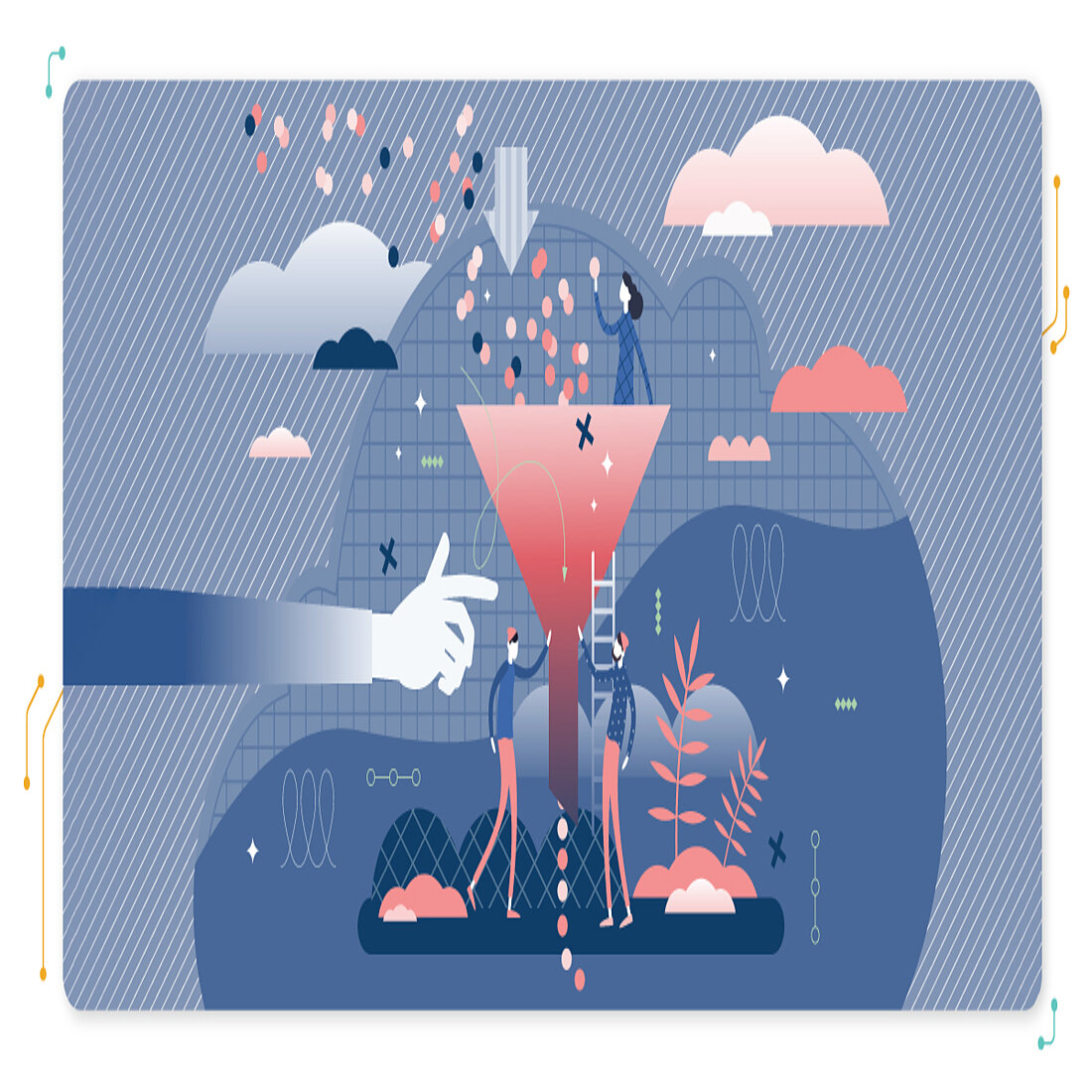
Bottom of the Funnel Optimization
Bottom-of-the-funnel optimization refers to the process of convincing prospects to make a purchase.
Much of this traffic will be new visitors, but optimization further up the funnel hopefully means that a large proportion will have traveled down from the top. This means that they will already be interested in your products, and just need a final push to move over the line and make a purchase.
As such, you need to ensure that the pricing pages provide them with all the information they need to take that final step. It should be well laid out, with everything explained clearly, and include remedies to any pain points that users might have.
The strength of your brand and online credibility will both also impact on your conversion rate at this point along the funnel. This is because - if users don’t trust you - they’ll be much less likely to open up their wallets, notwithstanding the strength of your conversion funnel.
But regardless of your business’ reputation, pricing will always be an issue for many internet users. As such, it’s important that you have used market research and competitor analysis to accurately calculate competitive pricing for your products, and to adequately explain the value that you’re providing buyers.
FAQs
What Is a Conversion Funnel?
The conversion funnel is a marketing and sales theory that maps out the full sales process. The funnel is a useful metaphor that illustrates the gradual erosion in prospects from the large number that find out about your business down to the number of people that convert (by buying a product or signing up to a service).
How Does a Conversion Funnel Work?
A conversion funnel is a business metaphor that illustrates the sales journey that customers take to conversion. New prospects enter the funnel from the top when they first become aware of your business. They then gradually move down the funnel towards the bottom as they build an interest in your products, before coming out the bottom of the funnel after buying something.
What Are the Stages in the Conversion Funnel?
The conversion funnel is based on Elias St Elmo Lewis in 1898. He called it the AIDA model, with the name an acronym of the key stages - awareness, interest, desire, and action. It’s been developed since then; some iterations include a final - retention - stage, while others divide his initial four stages further.
What Is the Difference Between Conversion Funnels, Marketing Funnels, and Sales Funnels?
Conversion funnel modeling underpins each of these types of funnels, and - somewhat confusingly - these terms are often used interchangeably. Marketing and sales funnels are both types of conversion funnel, and the difference between them is one of objective.
A sales funnel, for instance, refers to a process that shepherds prospective customers through to conversion, while a marketing funnel ends the process at the point when people provide their details and become leads.
What Is a Conversion Funnel in eCommerce?
A conversion funnel in eCommerce is a useful way of illustrating a specific, goal-orientated journey that internet users take through your business - from first hearing about your online store to making a purchase and beyond.
What Is the Top to Bottom Conversion Funnel Like on A SaaS Business?
SaaS companies generally do business online. For them, the top of the funnel refers to whatever outreach they’ve used to first attract specific internet users to their website. The bottom of the funnel refers to a conversion page, with the most common one existing for internet users to sign up to their service.
How to Calculate the Sales Funnel Conversion Rate
A conversion rate is the percentage of leads that performed a desired action. It can be worked out by dividing the number of conversion by the number of leads that existed at the top of the funnel, and multiplying this by 100:
Conversion Rate (%) = (Conversions / Leads) x 100
If, for instance, you had 50 people in a room and two of them bought something from you, then your conversion rate would be 4%. Online, it can be calculated by dividing the number of specific website goals that were achieved within a given time period by the total number of visitors it welcomed, and multiplying this by 100.
What Is a Good Funnel Conversion Rate?
A good conversion rate will be different depending on your type of business.
For eCommerce businesses, an effective marketing strategy can bring conversion rates up as high as 10%. However, the average online conversion rate sits between two and five percent, and anything within this range would be considered good.
For SaaS companies, it really depends on your own business model since the conversion rate for freemium plans can be much higher than for an alternative sales-led approach. These companies will also find that, while the final conversion rate is high, the proportion of visitors that turn into leads is lower.
What Is a Conversion Funnel in Web Analytics?
A conversion funnel in web analytics is a tool that is built on conversion funnel modeling. It enables you to connect various webpages together for the purpose of analyzing the chain’s effectiveness at converting website visitors into leads and then customers.
Can Conversion Funnels Show the Source of Converted Users?
Yes. When set up through a website analytics platform, conversion funnels will show the source of converted users. This is a great way to identify your top performing marketing campaigns and channels, and you can use this information to learn about your target audience and structure your marketing strategy accordingly.
How Can I Find Out the Efficacy of a Conversion Funnel On My Website?
Complete website analytics solutions like TWIPLA will automatically provide a site-wide conversion ratio for your website or eCommerce store, and you can also build conversion funnels from webpages that you want to analyze in more detail. You can also use specific conversion funnel software.
What Is the Best Way to Visualize a Conversion Funnel?
Ultimately, conversion funnels illustrate the erosion of internet users along the journey to purchase. As such, a bar chart is a useful way of displaying this information, though the number/ratio of them that moves through each stage of the funnel is easy enough to understand without any further illustration.
How Can I Create a Conversion Funnel?
A conversion funnel can be a theoretical approach to sales, but for digital marketers it can be best created by using the conversion funnel tool provided by advanced website intelligence platforms like TWIPLA. Ultimately, these are very simple to create, and can be set up in just a few minutes.
How Do You Optimize a Conversion Funnel?
Funnel optimization is the process of calibrating the full conversion funnel so as to increase the proportion of prospects that flow all the way down to conversion. Practically, this means performing conversion funnel analysis, and making data-driven improvements to stages with high drop-out rates.
How to Analyze a Conversion Funnel
Conversion funnels are easiest to analyze through a website intelligence platform or conversion funnel solution. Once the various webpages are connected together to form a funnel, it’s simply a case of looking at the percentage of prospects that drop out at each stage, and identifying the source for your highest quality leads that go on to convert.
How to Analyze the Conversion Funnel of a B2C SaaS Company?
Conversion funnels are an effective analytical approach for B2C companies. However, it’s important to create both separate and interlinking funnels between whatever revenue model that you’re using, since conversion rates will vary greatly for paid subscription converts and freemium signups.
Should eCommerce Conversion Funnels Include the Shopping Cart?
Since conversion funnels are easy to activate, it’s a good idea to have at least one that includes the shopping cart.
However it’s important to remember that there are a number of reasons why drop-off numbers from cart to checkout can be artificially high due to shoppers using shopping carts as wish lists that they plan to pay for at a later date.
Some shoppers also use the shopping cart as a way to see the total price before making a decision, while others will be pushed away by the upselling or cross-selling that happens at this stage of the buying journey.
How Do You Measure Improvements to a Conversion Funnel Over Time?
Conversion funnels provide basic information about the effectiveness of your funnels as conversion vehicles. The conversion funnel feature from web analytics platforms and other funnel solutions enable you to track funnel performance over time, but you can also do this manually by keeping a record of conversion rates across the funnel.
How Do I Build a Social Media Marketing Conversion Funnel?
A social media marketing conversion funnel is similar to any other funnel, and can be created through your website analytics platform by starting the funnel with a specific social media website landing page.
The awareness stage represents when social media users first discover your brand or products. The interest stage refers to pages where they can find out more about your business, and to compare the different product options available. Conversion represents the page at which they make a purchase, start some kind of trial, or become a sales lead by providing some contact details.
What Are the Most Important KPIs for Conversion Funnel Optimization?
Conversion funnel optimization is ultimately based on the number of internet users that arrive at the top of the funnel, and the number that perform a conversion at the bottom. However, other important information for conversion funnel optimization includes the following KPIs:
- Marketing cost per conversion
- Unique and returning website visitors
- Points of entry and exit along funnel
- Bounce rates
- Time spent browsing on webpage
- Marketing Qualified Leads to Sales Qualified Leads ratio
What Is the Best Automated Conversion Funnel/Sales Funnel Software?
Conversion funnel software has been purpose-built to help businesses manage and develop online sales, with some of the best platforms available being Hubspot, ClickFunnels, and Katra. Advanced website intelligence platforms like TWIPLA also provide a conversion funnel tool.
Why Are Conversion Funnels Effective in 2023?
Conversion funnel modeling has been adapted brilliantly for the digital age. Conversions are the end goal of all businesses, and conversion funnels provide businesses with a way to dissect their marketing strategy, and to see which elements are working well from this goal-oriented perspective, and which need work.
Improve Your Conversion Funnels with TWIPLA!
Now that you’ve scrolled this far down, you’ve hopefully got a better understanding of what conversion funnels are, how they work, and the work required to optimize the popular routes to purchase followed by your customers.
Conversion funnels represent a great way to simplify website optimization by focusing marketing activities around the work that is most likely to get you sales, particularly since the monitoring, analysis, and reporting is done automatically by website intelligence tools like TWIPLA.
If you liked what you read, and feel that it would help other marketers like you to learn how to best optimize their conversion funnels, then please share this resource hub with them!
Share article
You might also like
How to Use Conversion Funnels Effectively 17 November 2022 - by Simon Coulthard
17 November 2022 - by Simon Coulthard





